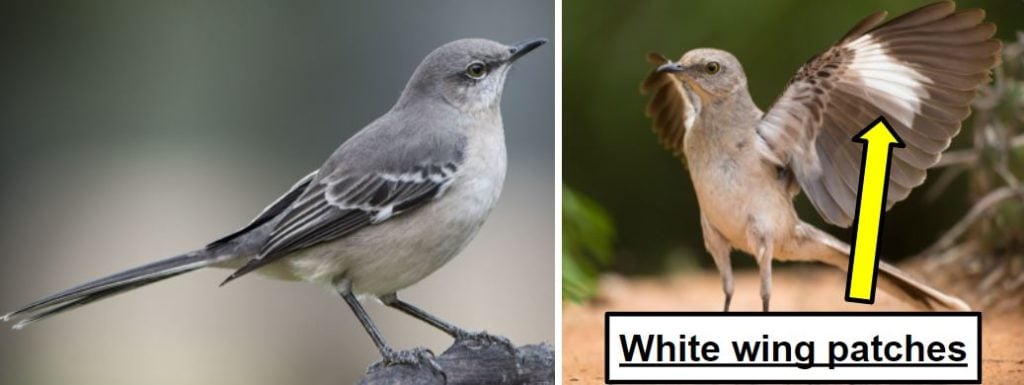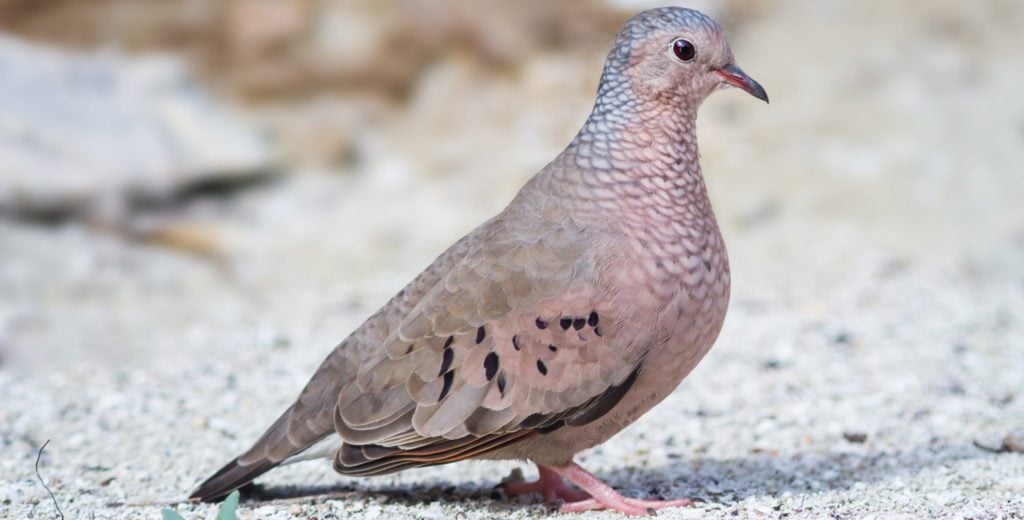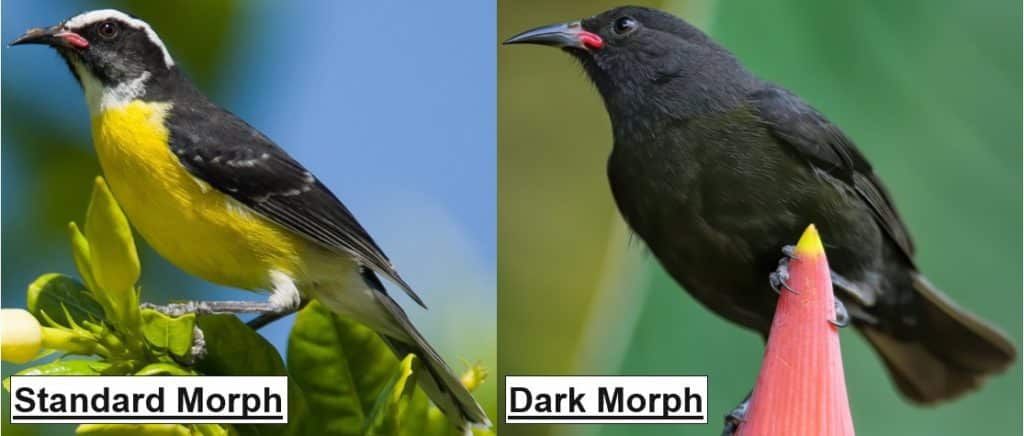16 Types of BIRDS Found on Haiti! (COMMON)
Below you will find 16 COMMON BIRDS that live in Haiti!

Believe it or not, over 270 species have been observed here, including many birds that only visit during migration. Because of the incredible variety, it would be impossible to list EVERY single type below.
So I did my best to come up with a list of the birds that are seen the MOST. Enjoy! 🙂
16 Common Birds of Haiti:
#1. Green Heron
- Butorides virescens

Identifying Characteristics:
- Small heron with a long, dagger-like bill.
- Their back is gray-green. Head and neck are chestnut-brown, except for the green-black cap on the head.
- The neck is commonly drawn into their body.
This small heron is found in Haiti in any wet habitat that includes lots of vegetation, which provides places for them to stay hidden. You will most often see them foraging at dawn or dusk, as they prefer to stay out of sight during most of the day.

Green Herons are ambush predators and mainly eat fish, waiting patiently for a small one to swim by so they can snap it up with their long bill. Interestingly, these birds actually use tools to help them hunt! They will drop insects, feathers, or other items into the water, which entice small fish to come closer to investigate.
The first time I heard the “skeow” call of an alarmed Green Heron, I had no idea what I heard because it was so unique. But luckily, these sounds are easy to learn, and now I can easily identify these herons when I’m visiting most wetlands.
#2. Great Egret
- Ardea alba

Identifying Characteristics:
- Large, white bird with long, black legs.
- S-curved neck and a dagger-like yellow bill. Look for a greenish area between their eyes and the base of the bill.
- While they fly, their neck is tucked in, and their long legs trail behind them.
Great Egrets are one of the most stunning birds in Haiti.
These herons especially put on a show during breeding season when they grow long feathery plumes called aigrettes, which are held up during courtship displays.
These aigrettes are so beautiful that Great Egrets were almost hunted to extinction in the 19th century because these feathers made such nice decorations on ladies’ hats. The National Audubon Society was formed in response to help protect these birds from being slaughtered. To this day, the Great Egret serves as the organization’s symbol.

#3. Caribbean Flamingo
- Phoenicopterus ruber

Also known as the American Flamingo.
Identifying Characteristics:
- Reddish-pink plumage.
- They measure from 120 to 145 cm (47 to 57 in) tall.
- The bill is white and pink with a large black tip.
These large birds are unmistakable in Haiti!
The best places to find Caribbean Flamingoes are in shallow, saline lagoons. Like all flamingoes, they have a specialized beak, which is hooked downward, perfect for finding and filtering food in these habitats. Some common food items include small crustaceans, mollusks, some worms, nematodes, insects and their larvae, small fish, etc.
Despite their beauty, Caribbean Flamingoes sound just like geese! Listen below:
#4. Northern Mockingbird
- Mimus polyglottos

Identifying Characteristics:
- Medium-sized grey songbird with a LONG, slender tail.
- Distinctive white wing patches that are visible when in flight.
These birds are hard to miss in Haiti!
First, Northern Mockingbirds LOVE to sing, and they almost never stop. Sometimes they will even sing through the entire night. If this happens to you, it’s advised to keep your windows closed if you want to get any sleep. 🙂
In addition, Northern Mockingbirds have bold personalities. For example, they commonly harass other birds by flying slowly around them and then approaching with their wings up, showing off their white wing patches.
#5. Common Ground Dove
- Columbina passerina

Identifying Characteristics:
- These doves are small, being only slightly larger than a sparrow!
- They have a plain grey-brown back. The underparts have a pinkish tint to them.
- Small heads with a scaled pattern on their breast and neck. Dark spots on the wings.
Common Ground Doves are typically easy to find in Haiti. Look for them feeding on the ground beneath bird feeders, cleaning up the grains and other seeds that fall from above.
These doves primarily nest on the ground! Simple nests are built lined with a few types of grass, weeds, and other plant matter. Being on the ground, they can make an easy meal for many predators. Their primary defense is to blend into their surroundings and thick vegetation.
Common Ground Doves are relatively vocal. They can be heard at all times of the day and at any time of the year. Listen for a repeated, soft, high-pitched coo with a rising inflection.
#6. Brown Pelican
- Pelecanus occidentalis

Identifying Characteristics:
- Brown skin on their giant throat patch.
- Dark gray bodies with a white neck and pale yellow head.
- Measures 3.5 – 5 feet in length (1 to 1.5 m) with a wingspan of 6.5 – 7.5 feet (2 to 2.3 m). The weight of adults can range from 4.4 to 11.0 lb (2 to 5 kg).
If you see a pelican in Haiti while sitting on a beach, it is most likely a Brown Pelican. These large birds live strictly in saltwater habitats near the ocean’s coastline. Interestingly, they rarely venture into the open ocean, staying within 20 miles of the shore.
It’s a lot of fun watching Brown Pelicans hunting for fish! First, they fly high into the sky and then plunge aggressively headfirst into the water. These dives are meant to stun the surrounding fish, which then are scooped up with their enormous throat pouch and swallowed whole.
Check out the below video to learn more about their insane dives!

And lastly, they birds live a long time. The oldest Brown Pelican on record was 43 years of age!
#7. American Kestrel
- Falco sparverius

The American Kestrel is the smallest bird of prey in Haiti.
But don’t let the tiny stature fool you because this raptor is an accomplished hunter. One of their favorite strategies to catch prey is to hover in the breeze from a relatively low height, looking for insects, invertebrates, small rodents, and birds.
Their diverse diet is one reason they can occupy ecological niches from central Alaska down to the southernmost tip of South America. But life can be tough when you’re the smallest falcon since they are sometimes eaten as prey by larger raptors and big snakes!
#8. Bananaquit
- Coereba flaveola

Identifying Characteristics:
- Adults range from 10-13 cm (4-5 in) long.
- Most adults have dark gray upperparts, a black crown, and a yellow chest, belly, and rump.
Bananaquits have something in common with many humans I know – a sweet tooth! Also known as “sugar birds” in Haiti, this species is attracted to nectar feeders and bowls of sugar. They even enter homes looking for sweet treats.
Bananaquits are small, colorful, and known for adapting easily to human habitats. They like fruit and nectar, so they spend a lot of time near humans near flower gardens or fruit trees.
This species’ reliance on humans doesn’t stop with their diet. They often build their nests on human-made objects, including lampposts and garden trellises. Look for a globe-shaped tangle of sticks and leaves between 5 and 30 feet (1.5 to 9 m) off the ground.
#9. Magnificent Frigatebird
- Fregata magnificens

Identifying Characteristics:
- Long, narrow wings with a deeply forked tail.
- Males have a red throat patch, which is easily seen during the breeding season.
- Females have a white breast patch.
As the name implies, seeing these seabirds soaring effortlessly in the sky is quite “magnificent.” Using their forked tails to steer, they barely have to flap to stay afloat in the sky.
Due to the fact that their feathers are not waterproof like other seabirds, Magnificent Frigatebirds rarely land in the water and spend almost their entire lives flying. For food, they commonly steal fish from other birds or harass them until they regurgitate their meal, which they grab in midair! Their pirating ways have earned frigatebirds the nickname the “man-o-war bird.”
With Magnificent Frigatebirds, the “early bird” does not get the worm! Most individuals don’t take flight until later in the afternoon when thermals and winds are at their greatest. 🙂
#10. Killdeer
- Charadrius vociferus

Identifying Characteristics:
- Adults are brownish-tan on top and white below, with two black bands on the neck.
Unlike most shorebirds in Haiti, Killdeer occupy dry habitats.
These birds feed primarily on small invertebrates, including earthworms, snails, and aquatic insect larvae. They also follow farm equipment, retrieving unearthed worms and insects. Killdeers are adept swimmers, even in swift water, despite spending most time foraging on land.
During the nesting season, the Killdeer is one of the best-known practitioners of the “broken-wing” display. They will feign an injury and attempt to lure predators away from their nest. They also puff up and charge at intruders, such as cows, to prevent them from crushing their eggs.
#11. Gray Kingbird
- Tyrannus dominicensis

Identifying Characteristics:
- Grayish bird with a whitish belly.
- Dark mask on the face that goes through the eye and cheek.
- Tail typically appears notched.
These birds are a lot of fun to watch in Haiti!
Gray Kingbirds are bold and expert hunters. They are known to chase dragonflies and other insects for over a hundred yards in spectacular fashion, reminiscent of a fighter pilot!
Gray Kingbirds are fairly easy to find due to their raucous and memorable voice. Listen for a rolling pitirre call anytime throughout the year.
#12. Greater Antillean Grackle
- Quiscalus niger

Identifying Characteristics:
- Males are glossy black with a tail that resembles a rudder.
- Females are black as well but less glossy. Smaller tails than males.
- Yellow eyes.
Greater Antillean Grackles are often found near people in Haiti, hanging around hoping to receive leftover food! These bold birds can become surprisingly tame, even going into restaurants.
Just like other grackles, this species is highly gregarious. You will most likely never see a Greater Antillean Grackle alone.
#13. Hispaniolan Woodpecker
- Melanerpes striatus

Identifying Characteristics:
- Gold and black barred woodpecker. It grows from 22 to 28 cm (8.7 to 11.0 in) in length.
- Males have a red crown and nape and are slightly larger than females.
Because of its bold and unique coloring, you won’t mistake a Hispaniolan Woodpecker for any other species. These birds are found in any wooded habitat on Hispaniola.
Unlike most other woodpeckers, this species is social. They live in colonies of up to 20 birds strong, and all the members help guard a nesting tree, which can house multiple nesting individuals.
#14. Palmchat
- Dulus dominicus

Identifying Characteristics:
- Olive brown with a brown-streaked white belly.
- A thick, yellow bill.
- Distintictive red eye. 20 cm (8 in) in length.
As the name suggests, the best places to find these birds in Haiti are habitats that include palm trees! Palmchats use palms for various activities, including feeding, roosting, and nesting. They have even adapted well to humans, assuming that the gardens, city parks, and backyards they inhabit have palms nearby.
Palmchats are social birds and prefer the company of other Palmchats. They roost together in small colonies and build large, communal nests together in the crowns of palms. These huge nesting structures can be up to 2 meters (6.5 ft) across and include 30 separate nesting chambers!
#15. Prairie Warbler
- Setophaga discolor

Identifying Characteristics:
- Adults are 4.3 to 5.2 inches long and weigh an average of 8 grams.
- Primarily yellow, with heavy black streaks. Males usually have a chestnut patch on their backs.
Even though their name suggests they prefer open fields and grassy areas, this bird lives in Haiti primarily in wooded habitats.
Look for a smaller bird that constantly bobs its tail up and down. Listen for its two similar songs, one for courtship and the other for marking territory. The quick, five- to six-syllable song rises sharply in pitch and sounds similar to a cricket’s chirping.

#16. Black-Throated Blue Warbler
- Setophaga caerulescens

Identifying Characteristics:
- Males are larger warblers with a small bill—deep blue on upperparts and white underneath, with a black face and throat.
- Females are greenish-gray all over; some have tints of blue on their wings or tail feathers.
- Both sexes have a white square patch on their wings, which will help to identify them.
This warbler breeds in the United States and migrates south to Haiti for the winter. And who wouldn’t want to do that!
Males sing to defend their territory and chase off other males. The songs are three or four syllables of rising notes, slightly deeper than other warblers. A funny way to remember their sound is to think of the phrase, “please, please, please squeeeeze.”

#17. Cape May Warbler
- Setophaga tigrina

Identifying Characteristics:
- Adults are 4.7 to 5.9 inches long and weigh 9 to 17 grams.
- Yellow, olive green, and brown with a red eye patch.
The reddish patch near the eye on males of the species is a sure sign you’ve seen a Cape May Warbler. On both male and female birds, look for a tiger-striped yellow belly and white bars on the black and yellow wings.
Their clear, high song sounds like “tsee-tsee-TSEE-TSEE,” starting soft and getting louder at the end.

Which of these birds have you seen before in Haiti?
Leave a COMMENT below! 🙂



